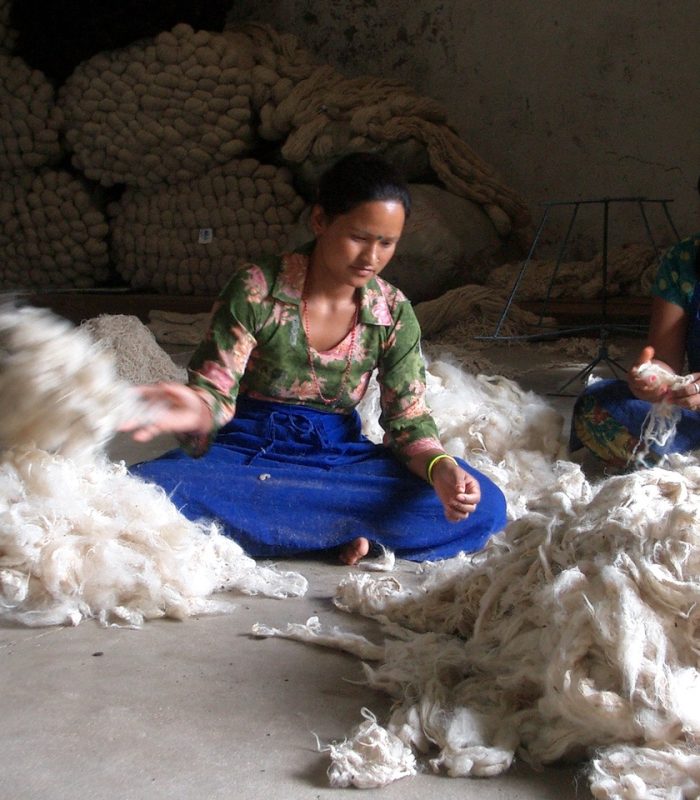Our
Carpets
Production
Our
Carpets
Production

Our carpets are entirely hand-knotted by skilled weavers and artisans using the ancient Tibetan technique. The warp is made of cotton, and the pile is crafted from pure wool, carded and spun by hand. All stages — carding, spinning, dyeing, knotting, shearing, washing, and finishing— are 100% handmade.
Wool and Cashmere Virtues:
The wool and cashmere used come directly from Tibet. Tibetan wool is among the finest natural fibers in the world for carpet production, for two main reasons: the pastures are mostly wild, and they are located at extremely high altitudes (5,000-6,000 meters). As a result, the wool is both durable and rich in lanolin.
Materials
In addition to wool, silk, and cashmere, we produce carpets using fibers such as aloe, hemp, linen, and viscose.(perche` nella stessa frase metti alcuni tessuti minuscolaprima parte e poi e alcuni maiuscole? Controlla udo nel documento, cambia in continuazione
Quality
We mainly produce in four qualities, distinguished by knot density and pile thickness: Uma, Yum, Shakti, and Millenium.
Our carpets are made in Nepal and are 100% eco-friendly; it is of fundamental importance to stress that no child or underage worker is employed by our factory. Thanks to foreign partnerships, a Montessori school of around 800 students has been established for the children of the factory employees, as well as a hospital open to all.
Selection of Wools
The finest yarns and the selection of the most renowned manufacturers in Tibet, Nepal, Pakistan, and Armenia guarantee carpets that are both beautiful and durable.
Carding and Spinning
CARDING
The first step in producing our carpets is carding. A handful of wool is placed between two metal brushes and is carefully rubbed until the fibers align. This process results in soft wool pads to be worked in the next stage, during spinning.
If this delicate operation were entrusted to a machine, the fibers would break apart, and the yarn would become too uniform, stripping the carpet of its character and vitality.
Hand carding is a process that is gradually disappearing due to its high costs but we believe that the quality and processing of the yarn are too important to be compromised.
SPINNING
Small wooden wheels are manually operated by highly skilled and experienced Tibetan artisans. The balance between the wheel and the artisan’s hand allows the wool “pad,” the result of carding, to be transformed into the perfect yarn that ultimately makes our carpets unique.
Dyeing
Wool dyeing is done by hand using pigments provided by a Swiss dyeing company, in small batches, following the Tibetan tradition. This ancient tradition is supported and enhanced by modern techniques, allowing Dinepiand to offer a wider range of colors, and enabling architects, artists, and designers to express themselves with contemporary carpets.
Knotting
Dinepiand carpets are hand-knotted using the ancient Tibetan Senneh knot. Knotting requires skill, precision, patience, and consistency. Each color point is the result of the movement of artisans’ hands who repeat daily gestures carrying ‘the sacredness of ritual’.
The knot is made on the cotton warp around a metal rod. Once a row is completed, the knots are cut, and the threads form the pile of the carpet.
Shearing
Once the knotting of the carpet is completed and the piece is removed from the loom, the surface of the pile is leveled using large steel shears. This requires oustanding skills and years of experience. After leveling the surface, the different color areas (the designs on the carpet) are shaped to highlight the carpet’s three-dimensionality.
Washing and Finishing
This phase is also carried out manually. The pure waters from the Himalayan range are poured onto the carpet pile and then dragged away with large wooden paddles. This operation is repeated multiple times for two main reasons: to remove any excess wool caught between the knots and to restore the brilliance of the colors.
Dinepiand carpet washes are completed with deep respect for the environment and are 100% eco-friendly.
FINISHING
These are the final touches—the meticulous inspection our pieces undergo, the stitching of the borders, and the covering of fringes with cotton bands. These last interventions vary in duration depending on the design created.

